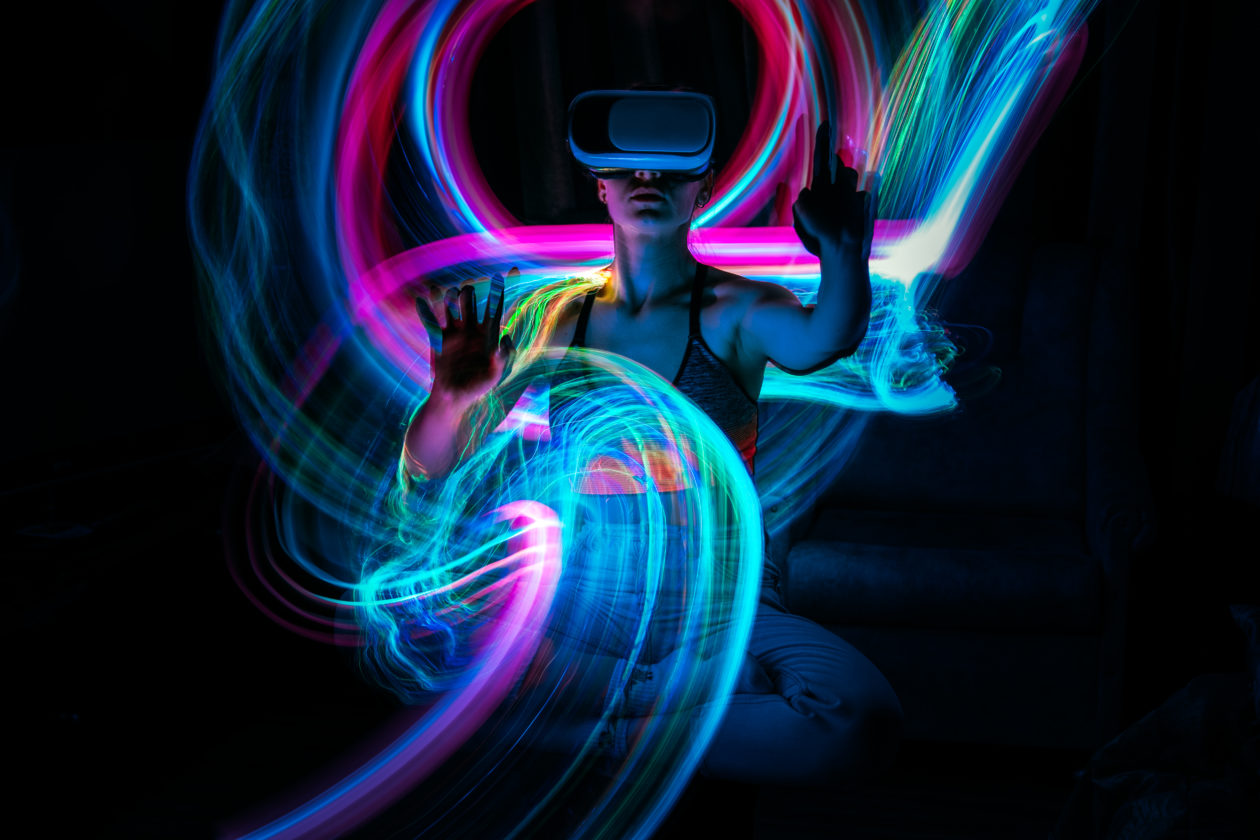The concept of the metaverse exploded into public awareness in November last year as a result of Facebook’s rebranding to Meta. The social media giant announced a US$10 billion bet on building the metaverse as the company’s “next computing platform” with the potential to transform how we live online, according to Facebook founder and CEO Mark Zuckerberg.
The prospect of a fully-immersive social media platform where it’s possible to explore virtual lives through digital avatars has been heralded as a major digital milestone.
Defining the metaverse is difficult because some of the building blocks are still in development. This explainer will look at what the metaverse is and some of its early iterations, beyond all the marketing hype.
This Forkast explainer will explore:
- What is the metaverse?
- What is the metaverse for?
- The role of blockchain in the metaverse
- Examples of the metaverse
- Industry voices
- How the metaverse is shaping our future
What is the metaverse?
The metaverse envisions an immersive, online, 3D virtual world that enables interaction through digital avatars. This enables users to bond through experiences shared in social exchanges and gaming.
Visiting the metaverse might be like taking a tour in an online video game environment, as some early iterations of the metaverse include World of Warcraft, Second Life, and Sims. These games allow players to square off with rivals in real-time through digital avatars.
More advanced iterations of the metaverse include Decentraland and The Sandbox, where users have more control over the digital world and accumulate in-game assets via non-fungible tokens (NFTs).
The term metaverse consists of the word “meta”, meaning “beyond” or “after” in Greek, and “universe”. The term was first coined in 1992 by American writer Neal Stephenson in his novel “Snow Crash”, which envisioned humans interacting with one another as digital avatars in a three-dimensional virtual reality environment. As it happens, “Snow Crash” was a mandatory read for Facebook’s management team at the beginning of the decade.
The metaverse is expected to replace our current internet infrastructure in such a way that social media platforms and communication software will become 3D, augmented reality worlds experienced through virtual reality headsets. Some industries have already transitioned to the virtual world. For instance, the Communication University of China has launched the country’s first virtual university, while the annual tennis event Australian Open has also launched on the metaverse.
What is the metaverse for?
The future metaverse is likely to combine the main aspects of our lives in one virtual space, namely work, entertainment, and socializing.
The need to work from home which arose from the Covid-19 pandemic has accelerated the shift towards remote digital interaction. The metaverse is taking this one step further by creating virtual 3D workplaces where you can interact with co-workers. For example, Meta’s Horizon Workrooms is already developing virtual meeting spaces to facilitate remote collaboration via virtual reality headsets.
The metaverse will also introduce more immersive social interactions. Users will be able to take part in shared experiences, either in virtual spaces or digital replicas of the physical world. Using augmented reality to create more realistic encounters and more ways of interaction represents a big step forward. For instance, you could host a birthday party at your virtual home for selected friends who would dial in remotely. The number of scenarios of hosting and meeting people in these new worlds is unlimited thanks to augmented reality technology.
The future of online gaming and entertainment is also heading in the same direction. Gaming is already home to some of the most immersive experiences, and the prospect of more advanced virtual reality is introducing new possibilities. While virtual reality would create hyper-realistic fantasy games in the metaverse, augmented reality could project digital games in the physical world as holograms. More advanced iterations could project other people’s avatars into your home for a game of chess or Texas hold ‘em. At Connect 2021, Meta announced its first fully-fledged augmented reality glasses codenamed Project Nazare, which are not available to consumers as they “are still a few years out”, according to the company’s blog post.
Metaverse gaming will also introduce new possibilities. These include combining work and gaming in what is already known as play-to-earn gaming. Games like Axie Infinity and MIR4 are already creating steady revenue sources for players, rewarding them with NFTs and cryptocurrency. Metaverse gaming models will likely incorporate similar economic incentives, rewarding players for their time invested in the game. Early iterations of play-to-earn metaverse games are already in development. One of them is the Japanese mobile game Elemental Knights Online which announced it will be releasing a play-to-earn metaverse version in August 2022.
The role of blockchain in the metaverse
Blockchain is closely intertwined with the metaverse as one of its core technological layers.
Imagine a digital realm where we work, play, socialize, and do our shopping. For the metaverse to become an extension of our physical lives, it needs a robust digital identity solution, in-built digital payments, and more. Most virtual worlds also need a secure and transparent voting system. Here are some of the main roles fulfilled by blockchain:
Facilitating secure value transfers via cryptocurrency
For the future of work and entertainment to go virtual, the metaverse will need a censorship-resistant method of value transfers. Cryptocurrencies offer a trustless, peer-to-peer alternative to digital payments which is faster and cheaper than traditional bank transfers. Moreover, crypto wallets will also hold in-game items such as NFTs.
Creating digital proofs of ownership via NFTs
Think of NFTs as unique digital records of metadata that live permanently on the blockchain. NFTs are the most secure solution to prove the authenticity, ownership, and scarcity of a digital item, thus virtual assets and items will exist as tokenized assets on the blockchain. NFTs are easily transferable cross-chain, meaning that tokenized items would enjoy complete interoperability.
Providing a decentralized governance structure
Having a decentralized governance structure is important for the metaverse. Blockchain introduces a user-controlled governance structure where governance token holders can vote on proposals. Similar voting systems are already being employed by community-governed blockchain protocols like Solana and Polygon, as well as in decentralized autonomous organizations (DAOs) where the voting power of users is proportional to the number of tokens they hold.
Offering economic incentives through DeFi
Much like today’s play-to-earn games, future virtual economies will require economic incentives that reward users for their achievements and time spent in the metaverse. These incentives will likely be powered by decentralized finance (DeFi). DeFi will offer services such as lending and borrowing, enabling metaverse participants to create additional income streams via staking and yield farming.
Building cross-chain interoperability
The metaverse will have to offer interoperability across multiple blockchains, technologies, and data environments for a seamless user experience. After all, users will want their digital avatars and items easily accessible across numerous metaverse projects. This level of interoperability will likely be assured by protocols like Polkadot, Avalanche, Cosmos, or Chainlink.
Examples of the metaverse
While the metaverse, as envisioned in its fully-immersive form, is not yet here, there are some projects already underway. The main difference between these projects is whether they are controlled by central authorities or the users themselves. Below are some of the most advanced metaverse projects:
Centralized platforms
Meta
Meta is one of the biggest companies building a centralized metaverse. It describes its project as a “hybrid of today’s online social experiences, sometimes expanded into three dimensions or projected into the physical world.” While its metaverse is not quite ready, Meta’s virtual world app, Horizon Worlds, was opened for everyone 18 and older in the US and Canada in December. Users can explore the world through VR headsets and partake in different social and gaming experiences built by other players.
Microsoft
In January 2022, Microsoft announced a US$68.7 billion acquisition of gaming giant Activision Blizzard as part of its strategy to gain a foothold in the metaverse. Microsoft Mesh, while still in its early stages, uses mixed reality applications to enable virtual collaboration and shared immersive experiences. Microsoft also offers an array of virtual reality games through SteamVR.
Decentralized platforms
Decentraland
Decentraland is a fully decentralized, 3D virtual world, controlled by its users via a DAO, which incorporates cryptocurrencies, smart contracts, and NFTs. Players can buy virtual plots of land as NFTs and build different gaming experiences or lend them to other developers in exchange for MANA, the project’s native currency. Decentraland was called “one of the leading blockchain-based virtual worlds” in a Grayscale report.
The Sandbox
The Sandbox is a community-driven, virtual world where players can buy tokenized virtual real estate and other digital assets to build social and gaming experiences. SAND, the game’s native currency, is used to transact in the metaverse, as well as for staking, liquidity mining, and governance. Landowners can rent their virtual land or create gaming experiences that can be monetized.
Netvrk
Netvrk brands itself as a “social-virtual world and platform” with creation tools that enable players to create, share, and monetize virtual experiences. Netvrk is also based on tokenized virtual land and assets. The project’s native currency, NTVRK, can be used to buy land, assets, advertising space, and for staking.
Industry voices
Alexander Mitrovich, CEO of Unique Network, believes that the metaverse will transform day-to-day activities. “Within the next couple of years we will start seeing a massive shift of work/employment that is based in metaverses,” Mitrovich said. “I also think dating will enter the metaverse.”
Others believe that health and wellness will become a major industry within the metaverse. “Human wellness will have a massive impact on how the metaverse operates,” David Nikzad said, CEO of Psilly, an online company dedicated to psychedelic research, that recently bought land in the Sandbox. Nikzad says the new medium will help make health therapies available globally and bring other benefits in the form of education, and psychedelic exploration.
Eaven Portillo, the COO of CryptoGene, sees the metaverse as changing “the evolution of science and research.” He also believes that the metaverse will bring a shift in how new employees are oriented into workplaces: “No matter where you are, you’ll be able to experience a company’s culture through extended reality experiences,” Portillo said.
Yet, the metaverse has to come with some important traits to fulfill its potential. Jay Chang, the co-founder of Genopets, believes it’s important for the metaverse to remain decentralized and interoperable.
“Decentralization will empower the average internet user by granting autonomy and freedom regarding the authority they have over the knowledge and control of their data and digital assets,” Chang said.
How the metaverse is shaping our future
While the futuristic metaverse envisioned in Ready Player One, where we work, play, and socialize, is still a long way off, it is steadily being developed by numerous companies and communities, along with its immersive technologies.
Grayscale, an investment firm that runs one of the world’s largest crypto funds, predicted that the metaverse will grow into a US$1 trillion market opportunity. In the same report, Grayscale estimated revenue from virtual gaming worlds could grow to US$400 billion in 2025, up from US$180 billion in 2020. Microsoft founder Bill Gates believes that the metaverse will become a go-to platform to host remote office meetings within two to three years, according to a blog post in December.
The metaverse holds out the promise to transform our education, social interactions, and professional lives. But the big question remains whether this brave new world will be centralized, with the same exploitive data mining practices that dominate today’s online world, or decentralized and user-controlled.





